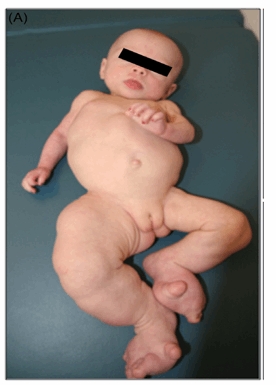Acronym for Congenital Lipomatosis Overgrowth Vascular malformations, Epidermal nevi and Spina /Skelet anomalies /Scoliosis.
(PROS)
Extremely rare. Most cases are due to mosaic somatic mutations of the PIK3CA gene (3q26.32).
Clinical presentation:
- abnormal and disproportionate distribution of the adipose tissue with outgrowth of soft tissue
- bone disease with frequent inequality of the limbs
- excessive growth of the trunk
- vascular (venous or arteriovenous) and lymphatic malformations
- sometimes cranial asymmetry with seizures.
- sometimes: renal hypoplasia.
Treatment: sirolimus or, more effective, BYL719 (alpelisib), specific inhibitor of the PIK3CA gene, used as antitumoral agent.
To be distinguished from Proteus and Klippel-Trenaunay syndrome (see those terms)

Anesthetic implications:
monitor renal function; thromboprophylaxis (in addition, there is often some chronic fibrinolysis at the level of large venous malformations); risk of epilepsy; difficult positioning because of the lipomatous masses.
References :
- Fernandez-Pineda I, Fajardo M, Chaudry G, Alomari A.
Perinatal clinical and imaging features of CLOVES syndrome.
Pediatr Radiol 2010; 40: 1436-9.
- Fontelles GG, Pastor JP, Moreillo CG.
Alpelisib to treat CLOVES syndrome, a member of the PIK3CA-related overgrowth syndrome spectrum.
Br J Clin Pharmacol 2022 Aug;88 :3891-5
- Kanji A, Cobben J, Laguda B.
CLOVES Syndrome.
JAMA Dermatology 2023 doi:10.1001/jamadermatol.2022.6180
Updated: April 2023